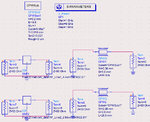khankim
Newbie level 3

- Joined
- Mar 13, 2009
- Messages
- 3
- Helped
- 0
- Reputation
- 0
- Reaction score
- 0
- Trophy points
- 1,281
- Location
- Seoul, Korea, South Korea
- Activity points
- 1,301
Hello guys.
I designed 2.59-GHz RF PCB Module using FR-4 substrate.
For RF connection, I'm using CPWG(Coplanar Waveguide w/ GND) on the PCB.
Test RF pattern, attached fig1, is drawn to know how it produces rf loss at the desired frequency.
And the pattern is measured using by network analyzer Agilent 8753.
The results was totally different as my expectation, so I compare s-parameter between the ideal CPWG line and test pattern.
Attached fig2, fig3 are ADS schematic and simulation&measurement results.
Blue line is the measurement, red line is the simulation.
As you can see, the measurement results has large variation, especially S21 along the frequency.
Is there someone who know why such that big difference between simulation and measurement occur?
Thanks in advance
KhanKim
I designed 2.59-GHz RF PCB Module using FR-4 substrate.
For RF connection, I'm using CPWG(Coplanar Waveguide w/ GND) on the PCB.
Test RF pattern, attached fig1, is drawn to know how it produces rf loss at the desired frequency.
And the pattern is measured using by network analyzer Agilent 8753.
The results was totally different as my expectation, so I compare s-parameter between the ideal CPWG line and test pattern.
Attached fig2, fig3 are ADS schematic and simulation&measurement results.
Blue line is the measurement, red line is the simulation.
As you can see, the measurement results has large variation, especially S21 along the frequency.
Is there someone who know why such that big difference between simulation and measurement occur?
Thanks in advance
KhanKim





